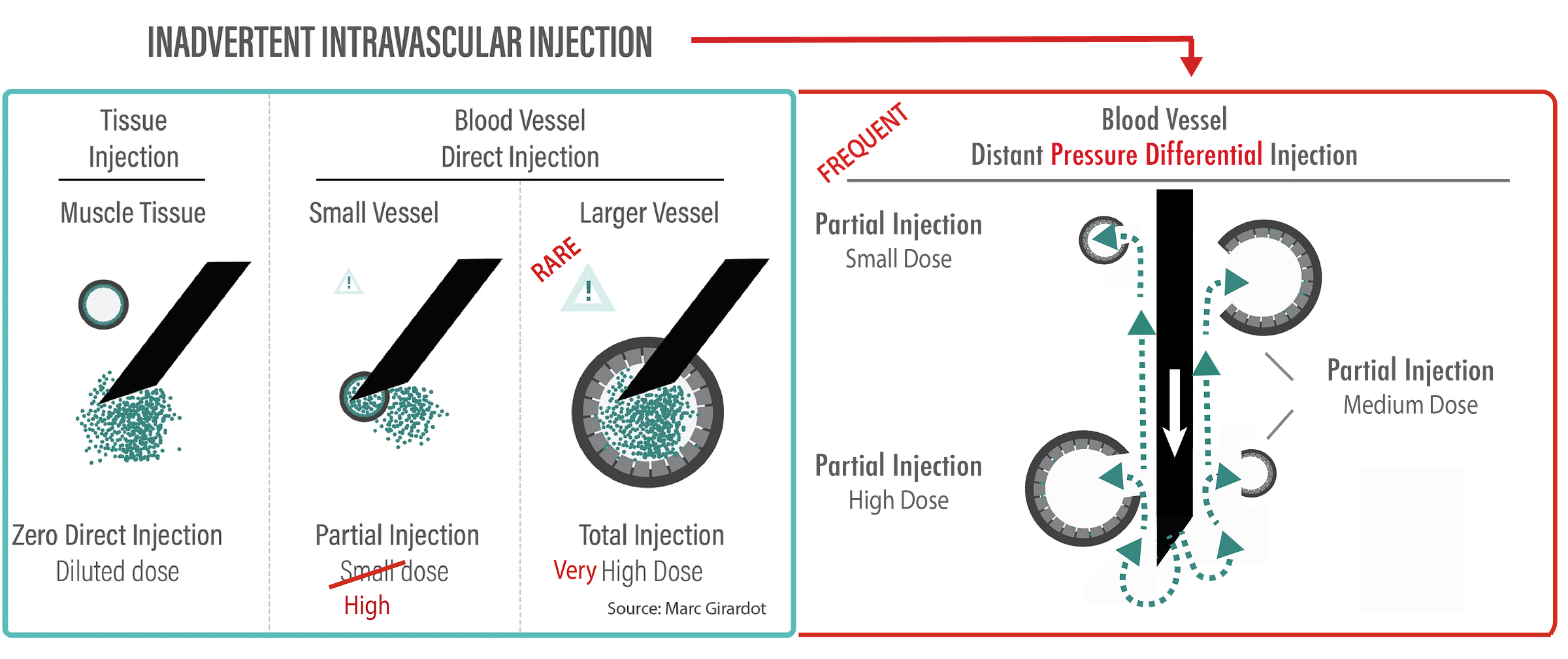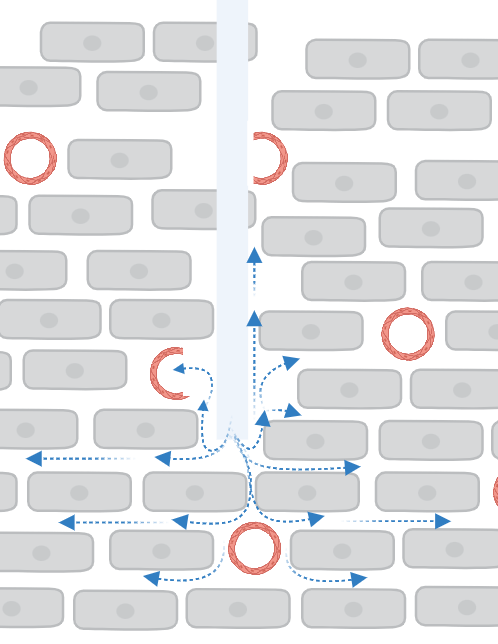The Greatest of Illusions
Basic Physics state all intramuscular injections likely go intravascular to a degree or another!
In this brief article, you will find an explanation of why all intramuscular go IV to some extent. I’ll explain a century old mistake that the entire medical and pharmaceutical community makes, and why the “Aspiration Technique” was never the panacea the medical community thought it was during decades.
In the past two days, I have been fighting two vicious battles: a plumbing one with a broken kitchen sink drain pipe; and another one with a group of French résistants on Twitter-X convinced inadvertent intravascular injection isn’t real or material, and casually and condescendingly dismissing the “Bolus Theory”.
(If you are new to the Bolus Theory, I gave a full debrief video with Dr Haider right before Xmas)
Frankly, I prefer fighting with that old tired pipe, even if it’s slimy and filthy, because at least it doesn’t get personal and doesn’t low blows.
So, yesterday evening, I was on my knees, trying to see what I can do to fix this mess, and, out of the blue, I found a plumbing analogy to explain why almost all intramuscular injection go intravascular (IV)…
For those of you who have used occasionally a traditional cup plunger to unblock a kitchen sink (I didn’t use one, but my brain did the synesthetic connection), you might have had the occasional jet of spoiled water right back at you, ruining your shirt or worse direct in your face. Like a living monster briefly coming out of the overflow hole!
You’re probably wondering: “Why is Marc talking about plumbing suddenly?” or “What’s the association between a cup plunger and accidental IV?”.
The physical concept behind the plunger accident is pretty simple as the extra-pressure exerted on the water and intended to unblock the drain, ends up finding areas of lesser pressure, compensate for gravity, and come back up and out the overflow hole. (Not sure whether it’s Pascal’s Law or Bernouilly’s Law…am sure I’ll get some comment soon from some of you)
When one uses the plunger and get splashed, one wasn’t expecting it, as one typically assumes the water going down, not up… Here, the framing is everything.
When I presented the Bolus Theory in my September 2022 article “When and How Can Vaccine Particles Hurt You? - A Visualisation Exercise”, I fell into the same framing trap everybody has been falling into for decades… A huge mistake.
I assumed there could only be one way to inject vaccine particles into a blood vessel, and that way was direct injection by having the needle inserted in the vessel, just like the pressured water pushed by the plunger could only go down, not up.
I did consider semi-insertion, but I assumed, without even giving a second thought about it, that - just like in real life - you need the nozzle to be inserted inside the gas filler neck to be able to fill your car with gasoline. Pr. Burkhardt also made the same mistake when he presented the needle touching a blood vessel in one of his conferences. Could it be that vaccine could be injected into blood vessels without the needle being inserting in any blood vessel?
Do you see my mistake?
Can you see the oversight made by millions of healthcare professionals for over a century regarding intramuscular injections?
A gas pump nozzle and a needle are absolutely not subject to the same Laws! Interstitial fluid isn’t compressible whereas air is compressible.
In other words, there’s no way gasoline can be filled in the tank remotely. Evidently, gasoline would fall on the ground. But that reality doesn’t apply to a vaccine injected in an incompressible fluid! Things are different with fluid dynamics. When a vaccine is injected inside a muscle, it will spread based on the path of least pressure, just like in the sink analogy. It will likely expand as a sphere in all directions, pushing the interstitial liquid away from the injection point.
If every cell in the body is a maximum two cells away from a capillary, it’s quite obvious blood vessels are necessarily systematic cut through when inserting the needle. Given the muscle density, it’s almost inevitable to hit a larger vessels arterioles and veinules connected to all these capillaries. Here Athletes are at a disadvantage since they have a denser vasculature in the deltoid. As such their probability is higher of rupturing blood vessels, explaining the myocarditis phenomenon with 16-25 year old men, and the epidemic of heart attacks on the field.
Now, most of the deltoid space is filled with muscle cells and blood vessels, so the immediate sphere of expansion of the liquid that should be 4 millimeters in a vacuum around the tip of the needle for Pfizer will more likely be around 9 millimeters around the tip of the needle, coming back up the needle’s insertion path and penetrating any blood vessel that has been ruptured.
Is it reasonable to think that in nearly 1 centimeter of insertion a needle won’t rupture any blood vessel? Frankly, given the fractal nature of blood vessels, it is not only certain that capillaries are ruptured, but there’s a good probability that either larger arteriole or veinule are also cut. The needle cannot find only muscles cells on its path. Depending on the size of the muscle cells, over the last 9 millimeters of the needle’s insertion, a back-of-the envelop calculation shows between 22 and 220 capillary or other blood vessels can be damaged.
This is a physical certainty: As long as the pressure differential is in favor of the vaccine fluid, the nanoparticles will penetrate in high concentration directly into the ruptured blood vessels.
The injected dose (read the Bolus) will be longer when the ruptured vessel is close to the needle’s tip, and shorter if it’s more distant. Why? because the pressure differential will be greater and longer closer to the needle’s tip.
The bigger the vessel (or the rupture), the bigger the bolus. And the smaller the vessel (or the cut), the smaller the bolus. It’s just a question of throughput capacity. At the same distance, a vessel with double the diameter will have a Bolus four times larger.
The worse case with the biggest IV dose would be a large vessel ruptured near the tip of the needle, that’s when the largest dose can be transferred as a bolus into the vascular system: a long injection with a wider aperture.
Then, close to the needle’s tip a smaller vessel with a smaller aperture and a long bolus, will get a medium dose, etc…
I have been fighting for two and a half years on the reality and the materiality of accidental intravascular injections. All the signs are there:
immediate taste in the mouth which can only happen with a direct introduction in the blood stream;
concentrated harm which can only be tied to a Bolus of vaccine particles that have transfected en masse;
exhausted lymphocytes (expressing PD-1) which only mean a drastically more effective transfection occurred, only a Bolus can do that
But the reality is that accidental IV are inevitable given the fluid dynamics and the high probability of rupturing vessels with the 1 inch needle.
The Aspiration Technique Is Necessarily Flawed
This also explains why the Aspiration Technique is likely not fully effective, because it’s simply not big enough to detect the blood of a distant ruptured blood vessel. So you might detect the most dangerous ones which are indeed relatively rare, rupturing a large vessel near the tip.
If the ruptured blood vessel is more than a millimeter away, detection is impossible. The aspirated liquid will be interstitial fluid, not blood. And so, there’s still a large potential for harm in the ruptured vessel close by, in the 1 to 3 millimeter range.
Between 4 and 6mm, the harm can still harm but likely in a more limited fashion, except if it’s a large vessel.
And between 7 and 10, the dose length is likely very small, here small vessels would trigger tiny boluses, that can may be harm but only very lightly the heart (likely the reason all the hearts were harmed in Professor Christian Müller’s study at Basel University Hospital) or possibly the brain, or create small distant micro-perforations.
In any case, it’s certain that accidental IV occurs and harms, and the only question is how often and how severe. It’s reasonable to think that 1 in 20 would cut a vessel within 3 mm of the tip, and systematically inject a significant dose causing all the AEs we have witnessed.
So the vast majority of the dose would expand in a sphere-like fashion in the muscle tissue, but a significant enough amount - may be 1 or 2 % or more if it’s very close - would go directly into the blood stream. I am not a Physics engineering, but it’s probably reasonably easy to simulate. Basic Physics is very clear: this is happening. This is just as certain as a push on the cup plunger on a blocked drain will come like a storm back at you when you try to unblock said drain.
Doctors, I have been talking to can’t understand that only by bypassing the body’s incredible protections can these vaccine harm. Poison is a question of dose. These vaccines are by design poison, they are cytotoxic. And they inject your loved-ones with 10 to 50 billion nanoparticles each capable of having the cell it transfects (penetrates) killed. The destructive power is humongous. No need to fantasize on graphene, on amyloids, on circulating spike or other biological boogeymen. The vaccine itself is very dangerous.
For safety, the filtering capacity and the disseminating capacity of our bodies are essential, but it shouldn’t come as a surprise that if we bypass those protections, harm will inevitably happen. This is why the Bolus Theory explains all the vaccine accidents.
I hope you enjoyed this brief article. I hope this analysis and analogy will help you convince people around you, and give you further elements to counter people who argue with you.
Feel free to support my family (who is having to move away from me this week because I can’t pay the rent) and my work, either directly via PayPal
or by upgrading to Founding Member.
A big hug. Marc











This explanation will really help with my nursing friend who has never seen any red upon aspiration after thousands of injections over the years. Thanks.
Thanks Marc. Doctors use ultrasound imaging to guide a needle for say steroid injections. There could be imaging technology to show what happens, in reality, when a needle is injected for vaccination. There would be your physics argument corroborated by imaging.